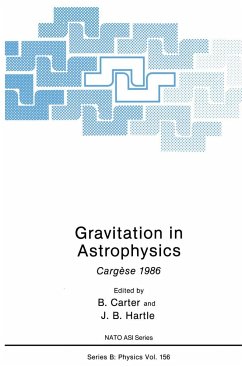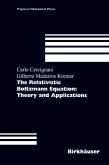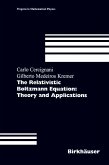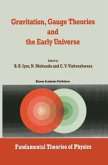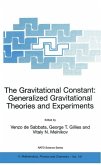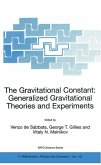B. Carter (ed.) / J.B. HartleCargèse 1986
Gravitation in Astrophysics
Cargèse 1986
Herausgegeben von Carter, B.; Hartle, J.B.
B. Carter (ed.) / J.B. HartleCargèse 1986
Gravitation in Astrophysics
Cargèse 1986
Herausgegeben von Carter, B.; Hartle, J.B.
- Gebundenes Buch
- Merkliste
- Auf die Merkliste
- Bewerten Bewerten
- Teilen
- Produkt teilen
- Produkterinnerung
- Produkterinnerung
With the discovery of pulsars, quasars, and galactic X-ray sources in the late 60's and early 70's, and the coincident expansion in the search for gravitational waves, rela tivistic gravity assumed an important place in the astrophysics of localized objects. Only by pushing Einstein's solar-system-tested general theory of relativity to the study of the extremes of gravitational collapse and its outcomes did it seem that one could explain these frontier astronomical phenomena. This conclusion continues to be true today. Relativistic gravity had always played the central role in cosmology. The…mehr
Andere Kunden interessierten sich auch für
![The Relativistic Boltzmann Equation: Theory and Applications The Relativistic Boltzmann Equation: Theory and Applications]() Carlo CercignaniThe Relativistic Boltzmann Equation: Theory and Applications145,99 €
Carlo CercignaniThe Relativistic Boltzmann Equation: Theory and Applications145,99 €![The Relativistic Boltzmann Equation: Theory and Applications The Relativistic Boltzmann Equation: Theory and Applications]() Carlo CercignaniThe Relativistic Boltzmann Equation: Theory and Applications192,59 €
Carlo CercignaniThe Relativistic Boltzmann Equation: Theory and Applications192,59 €![Deformed Spacetime Deformed Spacetime]() Fabio CardoneDeformed Spacetime121,99 €
Fabio CardoneDeformed Spacetime121,99 €![Gravitation, Gauge Theories and the Early Universe Gravitation, Gauge Theories and the Early Universe]() B.R. Iyer / N. Mukunda / C.V. Vishveshwara (eds.)Gravitation, Gauge Theories and the Early Universe249,99 €
B.R. Iyer / N. Mukunda / C.V. Vishveshwara (eds.)Gravitation, Gauge Theories and the Early Universe249,99 €![The Gravitational Constant: Generalized Gravitational Theories and Experiments The Gravitational Constant: Generalized Gravitational Theories and Experiments]() V. de Sabbata / George T. Gillies / Vitaly N. Melnikov (Hgg.)The Gravitational Constant: Generalized Gravitational Theories and Experiments168,99 €
V. de Sabbata / George T. Gillies / Vitaly N. Melnikov (Hgg.)The Gravitational Constant: Generalized Gravitational Theories and Experiments168,99 €![The Gravitational Constant: Generalized Gravitational Theories and Experiments The Gravitational Constant: Generalized Gravitational Theories and Experiments]() V. de Sabbata / George T. Gillies / Vitaly N. Melnikov (Hgg.)The Gravitational Constant: Generalized Gravitational Theories and Experiments166,99 €
V. de Sabbata / George T. Gillies / Vitaly N. Melnikov (Hgg.)The Gravitational Constant: Generalized Gravitational Theories and Experiments166,99 €![The Many Faces of Maxwell, Dirac and Einstein Equations The Many Faces of Maxwell, Dirac and Einstein Equations]() Waldyr A. RodriguesThe Many Faces of Maxwell, Dirac and Einstein Equations93,99 €
Waldyr A. RodriguesThe Many Faces of Maxwell, Dirac and Einstein Equations93,99 €-
-
-
With the discovery of pulsars, quasars, and galactic X-ray sources in the late 60's and early 70's, and the coincident expansion in the search for gravitational waves, rela tivistic gravity assumed an important place in the astrophysics of localized objects. Only by pushing Einstein's solar-system-tested general theory of relativity to the study of the extremes of gravitational collapse and its outcomes did it seem that one could explain these frontier astronomical phenomena. This conclusion continues to be true today. Relativistic gravity had always played the central role in cosmology. The discov ery of the cosmic background radiation in 1965, the increasing understanding of matter physics at high energies in the decades following, and the growing wealth of observations on the large scale structure meant that it was possible to make increasingly detailed mod els of the universe, both today and far in the past. This development, not accidentally, was contemporary to that for localized objects described above.
Hinweis: Dieser Artikel kann nur an eine deutsche Lieferadresse ausgeliefert werden.
Hinweis: Dieser Artikel kann nur an eine deutsche Lieferadresse ausgeliefert werden.
Produktdetails
- Produktdetails
- NATO Science Series B .156
- Verlag: Springer, Berlin
- 1987.
- Seitenzahl: 399
- Erscheinungstermin: 1. Juni 1987
- Englisch
- Gewicht: 859g
- ISBN-13: 9780306425905
- ISBN-10: 0306425904
- Artikelnr.: 27611923
- Herstellerkennzeichnung
- Libri GmbH
- Europaallee 1
- 36244 Bad Hersfeld
- gpsr@libri.de
- NATO Science Series B .156
- Verlag: Springer, Berlin
- 1987.
- Seitenzahl: 399
- Erscheinungstermin: 1. Juni 1987
- Englisch
- Gewicht: 859g
- ISBN-13: 9780306425905
- ISBN-10: 0306425904
- Artikelnr.: 27611923
- Herstellerkennzeichnung
- Libri GmbH
- Europaallee 1
- 36244 Bad Hersfeld
- gpsr@libri.de
I. Gravitation in Localized Systems.- An Introduction to the Theory of Gravitational Radiation.- 1. Introduction.- 1.1 Scope of these lectures.- 1.2 Conventions and Notation.- 2. What is a Gravitational Wave?.- 2.1 First viewpoint: propagation of discontinuities.- 2.2 Second viewpoint: high-frequency waves.- 2.3 Third viewpoint: weak gravitational waves on a flat background.- 2.4 Other viewpoints.- 3. Basic Problems of Gravitational Radiation Theory.- 3.1 A catalogue of problems.- 3.2 A catalogue of approximation methods.- 4. Quadrupole Moment Formalisms.- 4.1 "Quadrupole laws" versus "quadrupole equations".- 4.2 The three "quadrupole laws".- 4.3 General discussion of "quadrupole equations".- 4.4 The "standard," or "Einstein," far-field quadrupole equation.- 4.5 The "Landau-Lifshitz" quadrupole equation.- 4.6 The "Fock" quadrupole equation.- 4.7 Recent improvements.- 4.8 Thorne's generation formalism.- 4.9 Tentative conclusion about the "standard" far-field quadrupole equation.- 4.10 Far-field quadrupole equations for some specific problems.- 4.11 The generalized quadrupole equation of Halpern-Desbrandes and Press.- 4.12 The far-field multipole law.- 4.13 On the definition of the asymptotic outgoing radiation field.- 4.14 Energy-loss quadrupole equations.- 4.15 Radiation-reaction quadrupole equations à la Burke-Thorne.- 4.16 Post-Newtonian radiation-reaction quadrupole equations.- 4.17 Radiation-reaction quadrupole equations in the N-body problem.- 4.18 Conclusion.- 5. Multipolar-Post-Minkowskian Formalisms.- 5.1 Introduction.- 5.2 Formal framework.- 5.3 The hierarchy of equations to be solved.- 5.4 The first step of the hierarchy.- 5.5 On the meaning of the "algorithmic multipole moments".- 5.6 Recursive algorithm for constructing the higher steps of the hierarchy.- 5.7 Partial results on the asymptotic problem.- 5.8 Preliminary results on the propagation problem.- 5.9 Partial results on the generation problem.- 5.10 Preliminary results on the radiation-reaction problem.- 6. Gravitational Radiation and Binary Systems of Condensed Objects.- 6.1 One method for two questions.- 6.2 The two-condensed-body problem in General Relativity.- 6.3 The internal problems.- 6.4 The matching: internal ? external.- 6.5 The external problem.- 6.6 A convenient auxiliary mathematical technique.- 6.7 Answer to the first question of
6.1 (generation).- 6.8 Equations of motion of a binary system of condensed bodies.- 6.9 Radiation-reaction force versus the relativistic Laplace effect.- 6.10 Poincaré on gravitational waves.- 6.11 Answer to the second question of
6.1 (radiation reaction).- 6.12 Application to the binary pulsar PSR 1913+.- 6.13 Conclusion.- Acknowledgements.- Some Books Fully Devoted to Gravitational Radiation.- Bibliographical References.- Mathematical Foundations of the Theory of Relativistic Stellar and Black Hole Configurations.- 1. Introduction.- 1.1 Background.- 1.2 Purpose and Plan.- 2. Notions of General (Dynamic) Black Hole Theory.- 2.1 Definition.- 2.2 Kinematics of Characteristic (Null) Boundaries.- 2.3 Generalised Raychaudhuri Equation for Timelike and Null Geodesic Congruences.- 2.4 The Horizon of a Black Hole.- 2.5 Asymptotic Predictability, Closed Trapped Surfaces, and Apparent Horizons.- 2.6 Cosmic Censorship and the Existence of an Asymptotic Equilibrium.- 2.7 Approximate Equilibrium.- 3. Stationary and Static Equilibrium.- 3.1 Overview.- 3.2 Elementary Local Properties of Killing Horizons.- 3.3 Uniformity of the Corotating Potential on a Killing Horizon.- 3.4 Uniformity of K (the "zeroth law") on a Killing Horizon.- 3.5 The Mass of a Stationary System.- 3.6 Globally Bradyonic Character of Generators of Stationary D.O.C..- 3.7 The Staticity Theorem for Non-Rotating Electromagnetic Black Holes.- 3.8 Local Characterisation of Simply Connected Static Domain of Outer Communications.- 4. Axisymmetric Equilibrium States.- 4.1 Mass and Angular Momentum of Stationary Axisymmetric Systems.- 4.2 Circularity Theorem for Stati
6.1 (generation).- 6.8 Equations of motion of a binary system of condensed bodies.- 6.9 Radiation-reaction force versus the relativistic Laplace effect.- 6.10 Poincaré on gravitational waves.- 6.11 Answer to the second question of
6.1 (radiation reaction).- 6.12 Application to the binary pulsar PSR 1913+.- 6.13 Conclusion.- Acknowledgements.- Some Books Fully Devoted to Gravitational Radiation.- Bibliographical References.- Mathematical Foundations of the Theory of Relativistic Stellar and Black Hole Configurations.- 1. Introduction.- 1.1 Background.- 1.2 Purpose and Plan.- 2. Notions of General (Dynamic) Black Hole Theory.- 2.1 Definition.- 2.2 Kinematics of Characteristic (Null) Boundaries.- 2.3 Generalised Raychaudhuri Equation for Timelike and Null Geodesic Congruences.- 2.4 The Horizon of a Black Hole.- 2.5 Asymptotic Predictability, Closed Trapped Surfaces, and Apparent Horizons.- 2.6 Cosmic Censorship and the Existence of an Asymptotic Equilibrium.- 2.7 Approximate Equilibrium.- 3. Stationary and Static Equilibrium.- 3.1 Overview.- 3.2 Elementary Local Properties of Killing Horizons.- 3.3 Uniformity of the Corotating Potential on a Killing Horizon.- 3.4 Uniformity of K (the "zeroth law") on a Killing Horizon.- 3.5 The Mass of a Stationary System.- 3.6 Globally Bradyonic Character of Generators of Stationary D.O.C..- 3.7 The Staticity Theorem for Non-Rotating Electromagnetic Black Holes.- 3.8 Local Characterisation of Simply Connected Static Domain of Outer Communications.- 4. Axisymmetric Equilibrium States.- 4.1 Mass and Angular Momentum of Stationary Axisymmetric Systems.- 4.2 Circularity Theorem for Stati
I. Gravitation in Localized Systems.- An Introduction to the Theory of Gravitational Radiation.- 1. Introduction.- 1.1 Scope of these lectures.- 1.2 Conventions and Notation.- 2. What is a Gravitational Wave?.- 2.1 First viewpoint: propagation of discontinuities.- 2.2 Second viewpoint: high-frequency waves.- 2.3 Third viewpoint: weak gravitational waves on a flat background.- 2.4 Other viewpoints.- 3. Basic Problems of Gravitational Radiation Theory.- 3.1 A catalogue of problems.- 3.2 A catalogue of approximation methods.- 4. Quadrupole Moment Formalisms.- 4.1 "Quadrupole laws" versus "quadrupole equations".- 4.2 The three "quadrupole laws".- 4.3 General discussion of "quadrupole equations".- 4.4 The "standard," or "Einstein," far-field quadrupole equation.- 4.5 The "Landau-Lifshitz" quadrupole equation.- 4.6 The "Fock" quadrupole equation.- 4.7 Recent improvements.- 4.8 Thorne's generation formalism.- 4.9 Tentative conclusion about the "standard" far-field quadrupole equation.- 4.10 Far-field quadrupole equations for some specific problems.- 4.11 The generalized quadrupole equation of Halpern-Desbrandes and Press.- 4.12 The far-field multipole law.- 4.13 On the definition of the asymptotic outgoing radiation field.- 4.14 Energy-loss quadrupole equations.- 4.15 Radiation-reaction quadrupole equations à la Burke-Thorne.- 4.16 Post-Newtonian radiation-reaction quadrupole equations.- 4.17 Radiation-reaction quadrupole equations in the N-body problem.- 4.18 Conclusion.- 5. Multipolar-Post-Minkowskian Formalisms.- 5.1 Introduction.- 5.2 Formal framework.- 5.3 The hierarchy of equations to be solved.- 5.4 The first step of the hierarchy.- 5.5 On the meaning of the "algorithmic multipole moments".- 5.6 Recursive algorithm for constructing the higher steps of the hierarchy.- 5.7 Partial results on the asymptotic problem.- 5.8 Preliminary results on the propagation problem.- 5.9 Partial results on the generation problem.- 5.10 Preliminary results on the radiation-reaction problem.- 6. Gravitational Radiation and Binary Systems of Condensed Objects.- 6.1 One method for two questions.- 6.2 The two-condensed-body problem in General Relativity.- 6.3 The internal problems.- 6.4 The matching: internal ? external.- 6.5 The external problem.- 6.6 A convenient auxiliary mathematical technique.- 6.7 Answer to the first question of
6.1 (generation).- 6.8 Equations of motion of a binary system of condensed bodies.- 6.9 Radiation-reaction force versus the relativistic Laplace effect.- 6.10 Poincaré on gravitational waves.- 6.11 Answer to the second question of
6.1 (radiation reaction).- 6.12 Application to the binary pulsar PSR 1913+.- 6.13 Conclusion.- Acknowledgements.- Some Books Fully Devoted to Gravitational Radiation.- Bibliographical References.- Mathematical Foundations of the Theory of Relativistic Stellar and Black Hole Configurations.- 1. Introduction.- 1.1 Background.- 1.2 Purpose and Plan.- 2. Notions of General (Dynamic) Black Hole Theory.- 2.1 Definition.- 2.2 Kinematics of Characteristic (Null) Boundaries.- 2.3 Generalised Raychaudhuri Equation for Timelike and Null Geodesic Congruences.- 2.4 The Horizon of a Black Hole.- 2.5 Asymptotic Predictability, Closed Trapped Surfaces, and Apparent Horizons.- 2.6 Cosmic Censorship and the Existence of an Asymptotic Equilibrium.- 2.7 Approximate Equilibrium.- 3. Stationary and Static Equilibrium.- 3.1 Overview.- 3.2 Elementary Local Properties of Killing Horizons.- 3.3 Uniformity of the Corotating Potential on a Killing Horizon.- 3.4 Uniformity of K (the "zeroth law") on a Killing Horizon.- 3.5 The Mass of a Stationary System.- 3.6 Globally Bradyonic Character of Generators of Stationary D.O.C..- 3.7 The Staticity Theorem for Non-Rotating Electromagnetic Black Holes.- 3.8 Local Characterisation of Simply Connected Static Domain of Outer Communications.- 4. Axisymmetric Equilibrium States.- 4.1 Mass and Angular Momentum of Stationary Axisymmetric Systems.- 4.2 Circularity Theorem for Stati
6.1 (generation).- 6.8 Equations of motion of a binary system of condensed bodies.- 6.9 Radiation-reaction force versus the relativistic Laplace effect.- 6.10 Poincaré on gravitational waves.- 6.11 Answer to the second question of
6.1 (radiation reaction).- 6.12 Application to the binary pulsar PSR 1913+.- 6.13 Conclusion.- Acknowledgements.- Some Books Fully Devoted to Gravitational Radiation.- Bibliographical References.- Mathematical Foundations of the Theory of Relativistic Stellar and Black Hole Configurations.- 1. Introduction.- 1.1 Background.- 1.2 Purpose and Plan.- 2. Notions of General (Dynamic) Black Hole Theory.- 2.1 Definition.- 2.2 Kinematics of Characteristic (Null) Boundaries.- 2.3 Generalised Raychaudhuri Equation for Timelike and Null Geodesic Congruences.- 2.4 The Horizon of a Black Hole.- 2.5 Asymptotic Predictability, Closed Trapped Surfaces, and Apparent Horizons.- 2.6 Cosmic Censorship and the Existence of an Asymptotic Equilibrium.- 2.7 Approximate Equilibrium.- 3. Stationary and Static Equilibrium.- 3.1 Overview.- 3.2 Elementary Local Properties of Killing Horizons.- 3.3 Uniformity of the Corotating Potential on a Killing Horizon.- 3.4 Uniformity of K (the "zeroth law") on a Killing Horizon.- 3.5 The Mass of a Stationary System.- 3.6 Globally Bradyonic Character of Generators of Stationary D.O.C..- 3.7 The Staticity Theorem for Non-Rotating Electromagnetic Black Holes.- 3.8 Local Characterisation of Simply Connected Static Domain of Outer Communications.- 4. Axisymmetric Equilibrium States.- 4.1 Mass and Angular Momentum of Stationary Axisymmetric Systems.- 4.2 Circularity Theorem for Stati

